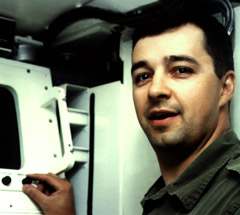|
The military uses a variety of highly technical sighting systems.
"Whether it be an armored fighting vehicle or an artillery piece
that has a straight panoramic sight, or uses night vision equipment,
we want to make sure that whatever piece of equipment soldiers
are using, they're shooting where they're aiming," Joe says.
Proper calibration
is crucial, of course - especially when it comes to tanks and
artillery pieces that fire shells over great distances. Joe notes,
"If you're firing a round 18 kilometres, a couple of millimetres
difference starting out makes a big difference in where the rounds
land."
Joe works
at the Canadian Forces School of Electrical and Mechanical Engineering
at CFB Borden near Barrie, Ontario, where he supervises a group
of four instructors and does a bit of teaching too.
Technicians
at the school quickly move from the basics to complex, sophisticated
equipment. Once they have mastered the theory of the trade, they
are ready to start trouble shooting and repairing a wide variety
of systems including laser, gunnery control, and missile guidance.
They have
to learn to be flexible too. Fire control systems technicians
can wind up doing all kinds of jobs - everything from fixing generators
and sighting devices to setting up transportable power grids in
the field. "In our trade, anything that is army and is electrical
usually winds up in our lap," Joe says.
A perfectionist
at heart, Joe is sometimes frustrated by the compromises that
tight deadlines impose: "The toughest thing to swallow is when
you're given a deadline and, due to operational requirements and
financial restrictions, you know you don't have time to do the
job the best it can possibly be done."
|


